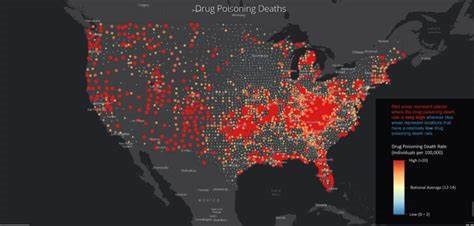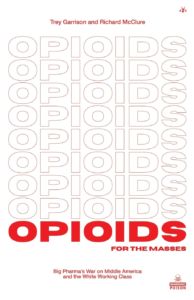Trey Garrison & Richard McClure
Opioids for the Masses: Big Pharma’s War on Middle America and the White Working Class
Quakertown, Pa.: Antelope Hill Publishing, 2021
Opioids are a major killer. This poison has infiltrated every part of the American heartland, especially the post-industrial Rust Belt and Appalachian coal country. Working-class white Americans whose parents and grandparents scorned the recreational drug users of the 1960s are now hopelessly addicted themselves. Trey Garrison and Richard McClure have published an easy-to-read book on this scourge’s origins and human impact.
The plague began with a single letter to the editor published on January 10, 1980 in The New England Journal of Medicine. This letter described a study which claimed that specific types of narcotics were found not to be addictive in most patients who had no prior addiction issues. The letter, however, “wasn’t supposed to be a carte blanche for opioids. It wasn’t even a real study. It was a large case anecdote” (p. 18). Yet, the letter was cited in medical literature hundreds of times to show that certain types of opioids were not addictive. The truth is that the claim only pertained to cases of acute pain where the opioids were being administered in the short term by medical professionals in a hospital, not by the patient themselves over a long period of time.
Then came the American Pain Foundation, which despite seeming respectable was actually a money-laundering front for Big Pharma. This organization pushed to make pain the fifth vital sign. Pain, however, is not a vital sign; it is a symptom of something that is wrong. Nonetheless, this push created a culture among doctors and patients to see pain as something to be eliminated through the routine use of painkillers.
OxyContin was approved for use in 1996, shortly after the economy-wrecking North American Free Trade Agreement (NAFTA) was ratified. OxyContin is the product of Perdu Pharma, a company owned by the Jewish Sackler family. They marketed OxyContin directly to patients, paid middlemen to get around regulators, and allegedly bribed doctors to prescribe opioids.
Very shortly thereafter, Americans started to get hooked. This epidemic’s insidious nature is due to the fact that many become addicted after being prescribed OxyContin by a doctor for a legitimate ailment. A patient who takes six opioid pills is at risk of becoming an addict, and will still be taking them a year later. Patients are first given opioids for pain, then later for withdrawal symptoms while Perdu Pharma and other drug companies rake in the money. The patient thus becomes an addict: a personal and professional ruin.
Legitimate use of opioids for pain would not have in itself been a problem except that Perdue’s sales strategy, along with the medical culture’s new belief that pain is a vital sign, allowed OxyContin to flood the market. The sheer number of pills that have been distributed is staggering:
Records and congressional testimony from 2018 show that from 2007 to 2012, distributors sent more than 780 million hydrocodone and oxycodone pills into West Virginia: 433 pills for every man, woman and child. One town of 400 residents was sent 9 million opioid pills in two years. Another, population 2,900, received almost 21 million pills during that decade. (p. 8)
Although these numbers should have raised eyebrows among medical regulators, the distribution was allowed to continue. Surprisingly, criminal gangs were also allowed to distribute relatively freely. There was an illicit opioid pipeline from Detroit to West Virginia that one gang operated for 15 years before it was rolled up by police.
The results of this epidemic are appalling. Young children have been found after their parents died two days before. The addicts’ houses are often wrecks, with the floors covered in dog feces. Some addicts turn to crime to support their habit, and some young, addicted women turn to prostitution. Teenage girls experiencing depression can also use opioids to attempt suicide; the book documents one such attempt.

Map of opioid deaths. Narcan has done a great deal to reduce overdose deaths, but the problems with addiction remain.
Perhaps the biggest problem with opioids are the massive opportunity costs. Admittedly, Appalachia and the Rust Belt are in dire economic straits, but in the past, many workers who were laid off or underemployed have gone on to create new industries and institutions. Addicts are unable to do this, however. Another problem is the instability within families that arises from drug use. Divorce, abuse, and addiction is thus passed on to the next generation, or children are not born at all.
The book documents doctors who have run pill mills in West Virginia and Kentucky. One, Katherine Hoover, lost her medical license after asking her female patients to have sex with her teenaged sons in exchange for medical services. She nevertheless continued to practice medicine under supervision. Her clinic in Williamson was the state’s biggest pill mill, and the town was dubbed “Pilliamson.” Some of the guilty doctors have names such as Mohammed or Mahmood, but many of them are Heritage Americans, too.
Quaaludes were a fashionable drug in the 1970s that is no longer used today. Its demise was brought about by good government. The US Drug Enforcement Agency (DEA) realized that the drug’s illicit distributors couldn’t manufacture the active ingredient on their own, so the DEA, through the US State Department, leaned on its manufacturers in various countries to cease making the product. Like disco music, Quaaludes didn’t make it into the 1980s.
Opioid trafficking in Appalachia was reduced when Florida cracked down on its own pill mills. One dealer was forced to cease operations because of that. He got clean and sober, and then started an addiction treatment service afterwards.
Cutting down on opioid abuse is unfortunately much more difficult than defeating Quaaludes was. Opium is derived from a plant, poppies, and it is easy to grow. For its part, the synthetic opiate fentanyl is easy to produce and is manufactured in America’s geopolitical rival China in great abundance. The Biden regime refuses to defend the country’s borders to stop drug smuggling. Opioids can thus easily cross the southwestern border.
Painkillers are nevertheless a necessary medicine. The authors write that
there are plenty of reputable and ethical pain clinics, but every drug court judge and cop we’ve spoken to also showed us that there is no shortage of these new pill mills. They just take a few extra steps and cost a little extra money. Those who are addicted or dependent are willing to go through the steps. And the dealers in white coats are happy to take the money. That’s how the game is played even when just days before, the federal government executed the largest opioid-related bust of health care providers in history. We’re led to conclude that even significant efforts by law enforcement do not scare physicians away from prescribing opiates, because they know that even a thin veneer of justification to make enforcement impossible or prohibitively difficult. (p. 123)
The opioid epidemic has many parents: doctors, Big Pharma, pharmacies, dealers, and the addicts themselves. But one cannot help but notice the appalling racial hostility apparent in this. West Virginia is a state peopled by those of the American majority –mostly Scots-Irish, but Pennsylvania Dutch and Anglo-Quakers as well. West Virginia thus represents a vital part of the white American race.
One woman interviewed by the authors says,
By now the country turns their backs on us. Meanwhile, they just brought in thousands of people from Syria and set them up in West Virginia with homes, schools, and money. But they won’t help the people right here. Our people . . . People aren’t replaceable. We won’t have American values without Americans. They want to replace us. (p. 42)
The authors go on to add:
To hammer the point that it wasn’t just simple greed or supply and demand market forces but actual malice that led to Big Pharma spreading their poisons in rural , working-class, White America, consider emails that came to light recently in the spring of 2021…Senior executives at one of the largest American drug distributors circulated rhymes and emails mocking “hillbillies” who had become addicted to opioid painkillers even as the company poured hundreds of millions of pills into parts of Appalachia at the heart of the opioid epidemic…one senior executive at a pharmaceutical distribution firm used the theme song to the old TV sitcom “The Beverly Hillbillies,” mocking Jed, “a poor mountaineer” who “barely kept his habit fed.” According to the re-tasked lyrics, “Jed: travels to Florida to buy “Hillbilly Heroin,” the nickname we saw in our travels, for OxyContin. (p. 145)
* * *
Counter-Currents has extended special privileges to those who donate $120 or more per year.
- First, donor comments will appear immediately instead of waiting in a moderation queue. (People who abuse this privilege will lose it.)
- Second, donors will have immediate access to all Counter-Currents posts. Non-donors will find that one post a day, five posts a week will be behind a “Paywall” and will be available to the general public after 30 days.
- Third, Paywall members have the ability to edit their comments.
- Fourth, Paywall members can “commission” a yearly article from Counter-Currents. Just send a question that you’d like to have discussed to [email protected]. (Obviously, the topics must be suitable to Counter-Currents and its broader project, as well as the interests and expertise of our writers.)
To get full access to all content behind the paywall, sign up here:
Paywall Gift Subscriptions
 If you are already behind the paywall and want to share the benefits, Counter-Currents also offers paywall gift subscriptions. We need just five things from you:
If you are already behind the paywall and want to share the benefits, Counter-Currents also offers paywall gift subscriptions. We need just five things from you:
- your payment
- the recipient’s name
- the recipient’s email address
- your name
- your email address
To register, just fill out this form and we will walk you through the payment and registration process. There are a number of different payment options.
Enjoyed this article?
Be the first to leave a tip in the jar!
Related
-
Think about It: Michael Nehls’ The Indoctrinated Brain, Part 3
-
Think about It: Michael Nehls’ The Indoctrinated Brain, Part 2
-
Are Whites Finally Waking Up?
-
Think about It: Michael Nehls’ The Indoctrinated Brain, Part 1
-
The Origins of Western Philosophy: Diogenes Laertius
-
Birch Watchers
-
Elizabeth Dilling on the Evil of the Talmud
-
Nowej Prawicy przeciw Starej Prawicy, Rozdział 5: Refleksje nad Pojęciem polityczności Carla Schmitta


13 comments
Good review but we have to put a lot of the blame on the users themselves. We’ve all had opioids at one time in our lives. They’re a necessary evil after a surgery. We don’t all become junkies in the process.
Low IQ take.
Whites are targeted with these poisons.
>> Good review but we have to put a lot of the blame on the users themselves. We’ve all had opioids at one time in our lives. They’re a necessary evil after a surgery. We don’t all become junkies in the process. <<
I agree. Oxycodone (the active ingredient of proprietary Oxycontin) has been around since 1916, literally a German wonder-drug.
A generation ago the dialog was that the medical establishment would try to do a better job at pain control management in order to circumvent increasingly strident talk about legalizing euthanasia ─ so instead of Soylent Green scenarios we would instead focus on respectable moral whinging over stuff like abortion, birth control, and divorce, LOL.
I’m no friend of the (((Sacklers))) but speaking as somebody who was run over by a junkie and has considerable experience in these matters where the rubber literally meets the road rash, these guys (the junkies and the dealers) just need a hard ticket to the concentration camp. And all the more so if they are White ─ because we should be expecting more from our own people, and holding them to some basic standards of decency.
I agree that the FDA should have been more stringent when approving high doses of Oxycontin, and that Purdue Pharma owes some liability for over-enthusiastic marketing practices ─ maybe even liability for billions of dollars ─ but that is not quite the same thing as “Genocide by Big Pharma.” Some edgy “dissident” podcasters ─ bless their hearts ─ just don’t know what they are talking about.
This issue is far larger than opiates and Appalachia. I can understand a Movement appeal to the youth, but I would offer that perhaps Zoomers just can’t understand that once you spend twenty or thirty years working for a living, maybe in a mine or a warehouse or whatever, that you really can’t get by without a decent health plan. And you probably won’t get a decent health plan working for McFries either. You will need a good healthcare plan regardless once you get older. These are all important and longstanding but unsolved issues.
Chronic pain is going to be an factor for many as they age, and NO, it isn’t like the frat house bros walking off their weekend hangovers like you did when you were 18 ─ er, I mean 21.
Is it any wonder that people who can’t afford more than one or two trips to the doctor a year don’t get any better healthcare than an Rx for Oxy, and that this therefore tends to be over prescribed? In my experience the Pajeet doctors do tend to be a little more empathic in this regard, fwiw. But the whole system is broken and there are many moving parts in play.
Furthermore, the opiate overdoses tend to be caused by street fentanyl plus hefty ethanol consumption, which do not mix well. It wasn’t Oxycontin or some obscure 1980 study in a medical journal, either. Not everything is as light-switch simple as da Joos ─ and this from somebody who thinks that the JQ needs to be discussed openly.
Another point is that all of the rending of garments over the “flood” of Oxy available doesn’t necessarily automatically prove any wrongdoing. We saw not long ago exactly what happens when ultra-lean or just-in-time inventory systems see a spate of minor supply chain disruptions, e.g., you couldn’t even get basic things like toilet paper, paper towels, and rubbing alcohol anywhere for almost a year during Covid. If they deliberately send ultra-lean amounts of medicine to Bumfuque County, how does this work out for low-income White patients exactly? How far do you have to drive and wait for your prescription to get written and successfully filled as a result? Controlled substances that have to be locked up and rigorously documented are even more complicated to distribute properly than rubbing alcohol.
What has happened now with the moral panic over the Opioid Crisis is that you can’t even get a damn prescription for Ambien (sleep medicine) anymore.
Today, medical providers who should know better are blind even to acute pain control because of some kind of phony moral hazard invariably associated with already complicated chronic health issues, plus some highly dysfunctional healthcare machinery that goes back far longer than thirty years ago. Every patient is now assumed to be a junkie unless and until vouchsafed otherwise. But suddenly Dr. Welby is all afraid of the DEA.
And for full disclosure, NO, I have not personally been on anything stronger than ibuprofen for almost ten years. I probably would not be alive today if I had not had a good health plan when I needed it. I think that is more important than the ever fashionable virtue-signaling about prescription opiates.
🙂
Thanks for the response. I recently had a surgery and was prescribed some opioids. I don’t know what I would have done for the first few days of recovery without them. Once the severe pain subsided I stopped taking them. I can honestly say that I don’t know what the attraction is. They constipate you and make you sick to your stomach. No pleasure whatsoever.
Excellent comment. Exactly correct. I’m sick of all this nationalist whining about opioids. I want to build the Wall; I have no objection to shooting fentanyl-carrying planes out of the sky, and mass-executing street dealers. But fentanyl, heroin, morphine (?) – these are illegal. So what is the author talking about? Vicodin, for bloody sake??? What the hell’s wrong with that?? I’ve had opioids prescribed on a number of occasions, and thank God for them! Is it the responsible medical user’s or chronic pain sufferer’s fault if some low-impulse control losers abuse these white-developed wonder drugs?
And note how the author conflates different groups of users. Is it Tramadol or Vicodin users who are ending up like this?
Young children have been found after their parents died two days before. The addicts’ houses are often wrecks, with the floors covered in dog feces. Some addicts turn to crime to support their habit, and some young, addicted women turn to prostitution.
No, it can be the users of fentanyl, but more normally methamphetamines (“tweakers”), who end up like this. And most tweakers are young jerks, with no excuse for their behavior.
I’m all in favor of a long period of Far Right authoritarianism to clean up our race (and this after the Ethnostate; it’ll be quite a while until Greg Johnson will get to enjoy his “nice, white country” -at least 25 years post-ethnostate founding before white lives will have returned to something like pre-90s (let alone pre-60s) normality). But in the meantime, we need to be clear about the type of strong-willed persons we need to cultivate. Those susceptible to drug addiction will not be of much use to our cause.
Yes but it’s a Tombstone Gazette view of the world: Here’s the truth and there’s the legend — Print the legend.
A Veterans affairs rep close by WILL NOT SPEAK to doctors for taking orders from the DEA and CDC instead of treating pain patients. Two local and apparently many veterans nationwide are committing suicide for lack of treatment, and the whole yarn about “diverting pain meds for drug abusers” is still being repeated by muck-raking books like the one above.
A real doctor, Josh Bloom, has a plethora of articles on the myth of painkillers versus illegal drugs and it only takes a short trawl through them to see the facts:
https://www.acsh.org/news/2021/10/05/analyzing-opioid-crisis-updated-100-articles-published-op-eds-15848
The CDC and DEA made a power grab a decade age. Thanks to citizens being fast asleep, a trip to your physician for any pain issue is now a check in to the Israeli-trained polices state. Such a deal.
Thank you for that excellent link.
I’m not someone who believes in pure libertarian drug legalization. But it is despicable to place trying to prevent losers (including white ones) who want to abuse drugs from doing so ahead of the needs of legitimate chronic pain sufferers. This is nothing less than a kind of pro-dysgenicist paternalism. I reject this. Decent people should always take precedence over low impulse control degenerates. Isn’t that a core principle of the Right?
“We don’t all become junkies in the process”. The fact that a small minority are able to overcome addiction is hardly proof that the majority are to blame. Oxycontin is a curse deliberately inflicted upon a people by the demonic greed and venality of the US pharma system. It is shameful that you would blame the simple and vulnerable people for this historic atrocity.
That almost sounds like a desperate argument in favor of some chlorine for the gene pool. Demon Rum isn’t that. And neither is Oxycontin.
🙂
For my part I’m glad I wasn’t t born 5 years later than I was. 18 year old me would not have hesitated to ingest a prescription drug recreationally, believing that it simply couldn’t be as bad as coke or any of the street drugs. Lots of kids from my hometown fell prey to oxy and several died.
Thanks for the review. It almost makes up for your strangely unqualified faith in the Warren Commision Report. https://counter-currents.com/2023/01/the-kennedy-assassination-misreading-data/
Ironic that the company name Purdue is a homonym for the French word for lost. Perhaps part of the reason why the Sacklers’ global brand, founded in 1952 in Frankfurt (original home of the Rothschilds) was Mundipharma, which may be even creepier albeit less obvious.
Admittedly, Appalachia and the Rust Belt are in dire economic straits
I have wondered if one appeal of an opioid habit is that having to track down a new fix every day gives addicts a structure – a purpose – to their lives that was otherwise lacking.
Probably not comparable, but I did find that buying my daily pack of cigarettes back when I was smoking gave me a much needed short-term goal.
Comments are closed.
If you have Paywall access,
simply login first to see your comment auto-approved.
Note on comments privacy & moderation
Your email is never published nor shared.
Comments are moderated. If you don't see your comment, please be patient. If approved, it will appear here soon. Do not post your comment a second time.
Paywall Access
Lost your password?Edit your comment